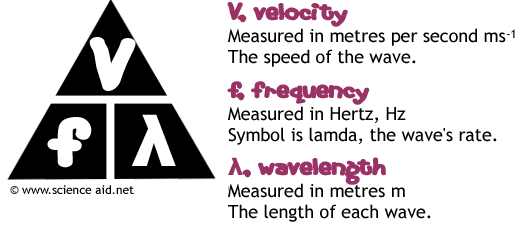Properties of Waves
A Wave

Above is a displacement / distance graph showing a wave. It is labeled with some key terms
Amplitude is the height of the wave from 0 displacement (normal) to the peak, where the peak is the highest point. The Wavelength is the distance from the start to the second point the wave passes 0. i.e. a complete wave.
Period: if it was a displacement/time graph, the period would be equivalent to wavelength, so period is the time for the wavelength. The frequency is 1 / period and measured in Hz (1Hz = 1wave per second).
The Wave Equation

Have a look at the examples using this equation, below.
A loundspeaker reproduces a note of frequency 320Hz. It travels through the air with a speed of 340ms-1.a) What is the wavelength in air?
l = v/f
l = 340ms-1 / 320Hz
l = 1.06m
b) The sound passes through water where its wavelength is 4.5m.
Calculate the speed of sound in water
V = fl
V = 320Hz x 4.5m (frequency doesn't change)
V = 1,440ms-1
Types of Wave: Transverse or Longitudinal?
There are two basic types of wave. They are
Transverse
The oscillation/vibration is at right angles to the direction of travel. An example of transverse waves are
electromagnetic waves

Longitudinal Wave
The oscillations/vibrations are along the line of travel.
Are mechanical waves because it actually moves particles. E.g. sound waves.

